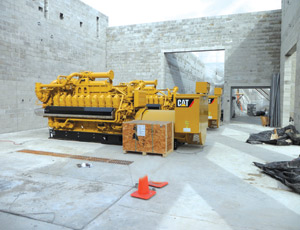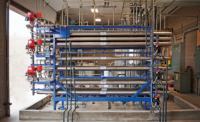The Prairie View Landfill and Recycling Facility in Wilmington, Ill., burns refuse-generated methane simply to rid the site of the substance. But rather than watch potential revenue go up in smoke, Houston-based Waste Management Inc. is constructing a $9.5-million generating plant at Prairie View to burn the gas and convert it to electricity.

Will County, which will receive up to $1 million per year in fees from the project, is using $1 million in federal economic stimulus funds from the U.S. Dept. of Energy to help finance the project. Waste Management is bankrolling the balance.
“It’s good for the environment, the county’s budget and consumers,” says Dean Olson, director of Will County’s resource recovery and energy division.
In a scheme the Will County board chairman, Jim Moustis, labeled “trash for cash,” the county will sell the methane to Waste Management, which will use it to fuel plant generators and sell the resulting power to local utility ComEd. Waste Management also will operate the landfill and assume ownership of the 6,000-sq-ft facility once construction is completed this summer.
One Million Homes
The plant initially will house three 20-cylinder engine generators, each producing 1.6 MW of electricity. The combined 4.8 MW will power about 3,000 homes.
Waste Management isn’t new to the game. It currently owns or operates more than 100 gas-to-energy facilities in North America, including 10 in Illinois. Many of them, Prairie View included, are constructed to contend with population growth and resulting strains on power grids. They collectively produce enough electricity to power more than 1 million homes.
Prairie View project manager Michael J. Ross currently is overseeing construction of six such projects in states ranging from Virginia to Minnesota. “We start with a standard design, but each project is different, depending on the needs of individual sites,” he says.
Prairie View’s foundation employs conventional spread footings made of cast-in-place concrete, a 6-in.-thick concrete slab and 18-in.-thick reinforced pads to receive the project’s engine generators. Walls are constructed of concrete block, with steel beams and joists supporting a single-ply roof.
The plan may be simple, but complexities lie elsewhere, says Ross.
In addition to the methane-fueled engine generators, the plant will house the equipment and piping to collect the gas, then dewater and filter it before the generators burn it as fuel. Waste Management also is constructing the project’s waste-recovery system, which consists of a series of wells drilled into buried waste, as well as a vacuum to draw gas through a network of pipes. Wastewater will be stored in an underground tank until it is shipped to a treatment facility.
To simplify logistics, Waste Management hired Butler, Wis.-based T.V. John and Son Inc. to vet local contractors and serve as its onsite representative. However, Waste Management selected the contractors and dealt directly with each of them on a design-bid-build basis. It also is buying much of the plant equipment directly from suppliers.
The plant is designed to accommodate a fourth generator. Plans also call for construction of an adjoining facility to house four additional generators in the event environmental and economic conditions remain favorable. At maximum capacity, the plant could generate up to 12.8 MW of electricity, an amount sufficient to power 8,000 homes.
Decomposition will continue to create gas long after the landfill achieves capacity, meaning the plant could continue to generate revenue for up to 30 years. At present, each of the landfill’s 10 cells measures 22 acres, with a combined capacity of 20 million tons.
Prairie View is one of a growing number of landfill-gas plants sited in the Midwest, according to Swarupa Ganguli, who oversees the U.S. Environmental Protection Agency’s Landfill Methane Outreach Program in the Midwest. Since 1995, the number of U.S-based landfill-gas plants has swelled to 541 from 145.
Ganguli attributes the growth to greater environmental awareness and the availability of tax credits for Prairie View and projects like it. As a result, the projects make use of a naturally occurring resource that would otherwise go to waste.
Article toolbar


Post a comment to this article
Report Abusive Comment